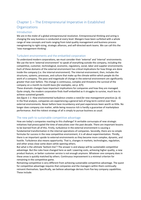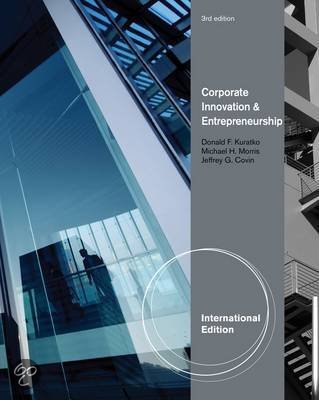Chapter 1 – The Entrepreneurial Imperative in Established
Organizations
Introduction
We are in the midst of a global entrepreneurial revolution. Entrepreneurial thinking and acting is
changing the way business is conducted at every level. Mangers have been surfeited with a whole
range of new concepts and tools ranging from total quality management and business process
reengineering to right-sizing, strategic alliances, and self-directed work teams. We can call this the
‘new management thinking’.
Turbulent environments and the embattled corporation
To understand modern corporations, we must consider their ‘external’ and ‘internal’ environments.
We use the term ‘external environment’ to speak of everything outside the company, including the
competitive, customer, technological, economic, regulatory, social, labor and supplier environments.
Each of these domains of the external environment has critical implications for how things are done
inside the company (i.e. the internal environment). The internal environment, then, includes the
structures, systems, processes, and culture that make up the climate within which people do the
work of a company. The pace and magnitude of change in the external environment are significantly
greater than ever before. The change is continuous, complex and threatens the survival of the
company on a month-to-month basis (for examples, see p. 4/5).
These dramatic changes have important implications for companies and how they are managed.
Quite simply, the modern corporation finds itself embattled as it struggles to survive, much less to
achieve sustained growth.
See figure 1-1: How environmental turbulence creates a need for new management practices (p. 6).
In the final analysis, companies are experiencing a general lack of long-term control over their
external environments. Never before have incumbency and past experiences been worth so little. No
longer does company size matter, while being resource rich is hardly a guarantee of marketplace
performance. And the riskiest strategy of all is simply to pursue business as usual.
The new path to sustainable competitive advantage
How are today’s companies reacting to this challenge? A veritable cornucopia of new strategic
initiatives had preoccupied the time of executives over the past decade. There are important lessons
to be learned from all of this. Firstly, turbulence in the external environment is causing a
fundamental transformation in the internal operations of companies. Secondly, there are no simple
formulas for success in the new competitive environment, it is all about experimentation. Thirdly,
there is an important upside to external environments as they become more complex, dynamic, and
hostile. Turbulence also means opportunity. That is, changes in markets, technologies, regulation,
and other areas close some doors while opening others.
But what is the ultimate ‘bottom line’? The answer is and always will be sustainable competitive
advantage. But the rules have changed here as well. Lowering costs, achieving higher quality, a new
product feature, or better customer service is not enough anymore. Whatever one company does in
these areas is quickly matched by others. Continuous improvement is a minimal criterion for
remaining in the competitive game.
Remaining competitive is very different from achieving sustainable competitive advantage. The quest
for competitive advantage requires that companies and the managers within them continually
reinvent themselves. Specifically, we believe advantage derives from five key company capabilities.
These include:






